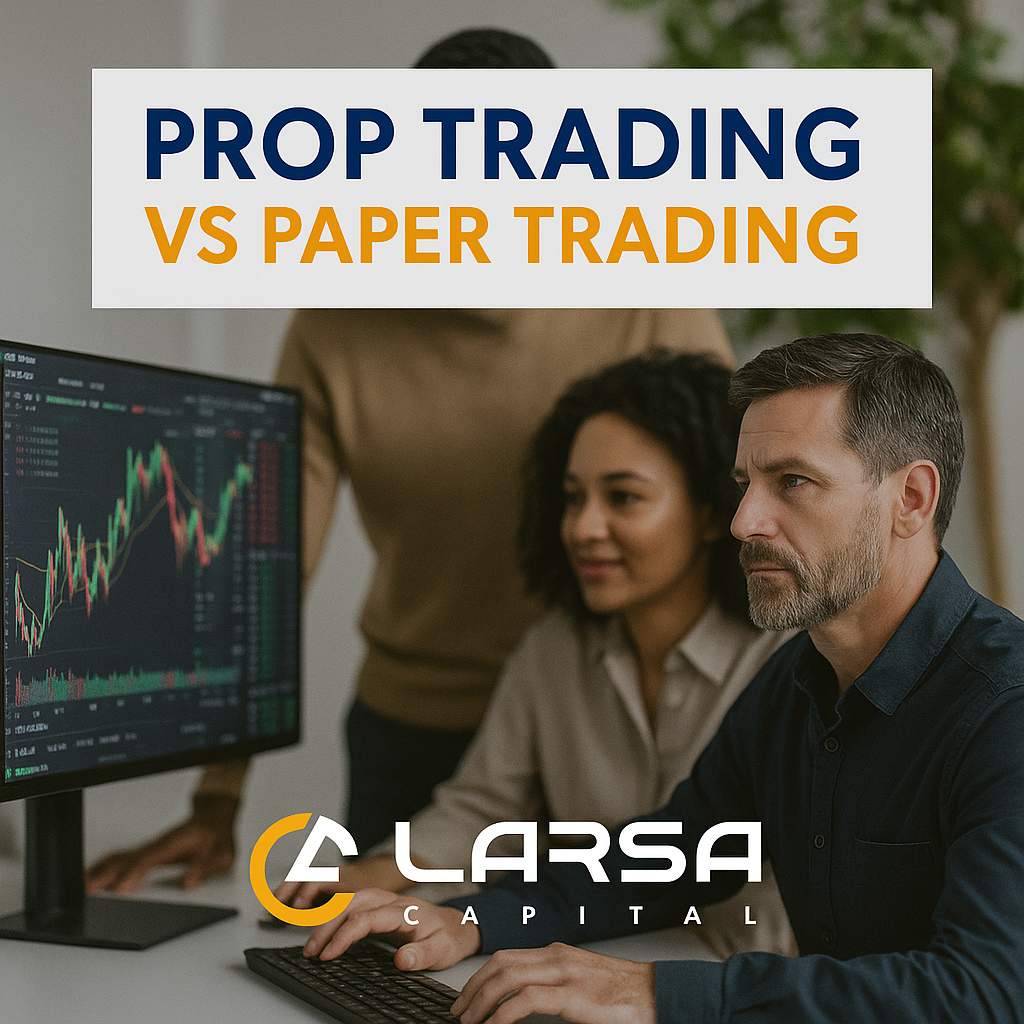Prop Trading vs Paper Trading: What’s the Difference?
Understanding Prop Trading vs Paper Trading
For aspiring traders, grasping the distinction between prop trading vs paper trading is essential. These terms often surface during the early stages of a trading career, yet their meanings, applications, and consequences vary significantly. Understanding the real-world stakes, benefits, and limitations of each will help you align your strategy with your financial and professional goals.
In this article, we break down the major differences between proprietary (prop) trading and paper trading, offering actionable insights to help you decide which one best serves your development as a trader.
What Is Prop Trading?
Prop trading, or proprietary trading, involves using a firm’s capital to execute trades. Traders don’t risk their own funds; instead, they operate under strict guidelines and aim to profit for the company, receiving a performance-based share in return.
Larsa Capital, for instance, provides traders with access to substantial capital and evaluation models, allowing them to scale based on performance. This model is ideal for skilled traders who are ready to operate in real market conditions and aim for consistent profitability.
Key features of prop trading:
- Access to large trading capital
- Profit-sharing models
- Real-time market execution
- Evaluation phases and strict risk rules
- Payouts based on performance
What Is Paper Trading?
Paper trading refers to simulated trading environments where individuals use virtual money to place trades. While it replicates real-time market movements, no real money is involved, making it a safe space for learning without financial risk.
Key features of paper trading:
- No real money or capital risk
- Simulated market environment
- Useful for beginners and testing strategies
- Often available on trading platforms for free
- No financial gain or loss involved
Prop Trading vs Paper Trading: Core Differences
Let’s dive deeper into the primary distinctions when comparing prop trading vs paper trading.
1. Risk and Reward
- Prop Trading: You trade real money and can earn real profits. However, failure to adhere to risk parameters could lead to losing the account.
- Paper Trading: Zero financial risk. No actual gains or losses. It’s ideal for experimentation.
2. Psychological Impact
- Prop Trading: Real capital triggers emotions like fear and greed. Managing psychology becomes crucial.
- Paper Trading: No emotional consequences. Traders may act more carelessly.
3. Learning Curve
- Prop Trading: Offers accelerated learning in high-pressure, real-market conditions.
- Paper Trading: Great for early practice but may create unrealistic confidence.
4. Access to Resources
- Prop Trading: Includes tools, mentorship, and firm-backed risk controls.
- Paper Trading: Generally limited to platform capabilities without guidance.
5. Career Progression
- Prop Trading: Traders can build a career, scale capital, and establish track records.
- Paper Trading: Best used as a stepping stone toward live trading.
When Should You Start Paper Trading?
Paper trading is an excellent starting point for:
- Newcomers learning platform mechanics
- Testing new strategies in different market conditions
- Gaining confidence before funding a real account
It helps reduce the overwhelm of jumping straight into high-stakes trading and lays the foundation for more disciplined behavior.
When Is It Time to Move to Prop Trading?
Once you’ve spent adequate time paper trading and understand your strategy’s strengths and weaknesses, consider stepping into a prop trading environment. Firms like Larsa Capital offer structured programs to evaluate and grow your skills in live markets.
Signs you’re ready:
- Consistent paper trading success over a defined period
- Clear understanding of trading psychology
- Risk management knowledge
- Desire to turn trading into a profession
Common Myths: Prop Trading vs Paper Trading
“If I’m good in paper trading, I’ll do just as well in prop trading.”
False. Real money changes your psychological behavior.
“Prop trading is only for experts.”
Also false. Many firms like Larsa Capital offer scalable models suited for intermediate traders ready to level up.
“Paper trading doesn’t teach anything valuable.”
Wrong again. It builds foundational skills and familiarizes traders with platforms and market timing.
Key Takeaways: Which Is Right for You?
Choosing between prop trading vs paper trading depends on your experience level, goals, and risk tolerance.
| Feature | Prop Trading | Paper Trading |
|---|---|---|
| Capital | Firm-funded | Simulated |
| Risk | Real | None |
| Learning Speed | Fast | Slow to moderate |
| Emotions Involved | High | Low |
| Suitable For | Intermediate/advanced | Beginners |
If you’re just starting out, paper trading can serve as a reliable training ground. But if you’re aiming to build a career, scale profits, and test yourself in the real market, prop trading is the logical next step.
Final Thoughts: Transition With Intention
Many traders see prop trading and paper trading as mutually exclusive. In truth, they are sequential tools. One prepares you; the other tests you. Success lies in knowing when to shift gears.
Larsa Capital bridges the gap by offering comprehensive evaluations, funding, and community support to help you thrive in real markets.
Evaluate where you are in your trading journey. Then choose the path that strengthens your growth trajectory.
Ready to transition from simulation to success?
Explore prop trading opportunities with Larsa Capital and step into the markets with real confidence.

